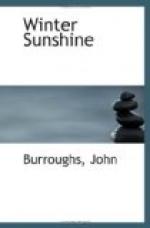London has less metropolitan splendor than New York, and less of the full-blown pride of the shopman. Its stores are not nearly so big, and it has no signboards that contain over one thousand feet of lumber; neither did I see any names painted on the gable ends of the buildings that the man in the moon could read without his opera-glass. I went out one day to look up one of the great, publishing houses, and passed it and repassed it several times trying to find the sign. Finally, having made sure of the building, I found the name of the firm cut into the door jamb.
London seems to have been built and peopled by countrymen, who have preserved all the rural reminiscences possible. All its great streets or avenues are called roads, as King’s Road, City Road, Edgware Road, Tottenham Court Road, with innumerable lesser roads. Then there are lanes and walks, and such rural names among the streets as Long Acre, Snowhill, Poultry, Bush-lane, Hill-road, Houndsditch, and not one grand street or imperial avenue.
My visit fell at a most favorable juncture as to weather, there being but few rainy days and but little fog. I had imagined that they had barely enough fair weather in London, at any season, to keep alive the tradition of sunshine and of blue sky, but the October days I spent there were not so very far behind what we have at home at this season. London often puts on a nightcap of smoke and fog, which it pulls down over its ears pretty close at times; and the sun has a habit of lying abed very late in the morning, which all the people imitate; but I remember some very pleasant weather there, and some bright moonlight nights.
I saw but one full-blown characteristic London fog. I was in the National Gallery one day, trying to make up my mind about Turner, when this chimney-pot meteor came down. It was like a great yellow dog taking possession of the world. The light faded from the room, the pictures ran together in confused masses of shadow on the walls, and in the street only a dim yellowish twilight prevailed, through which faintly twinkled the lights in the shop windows. Vehicles came slowly out of the dirty obscurity on one side and plunged into it on the other. Waterloo Bridge gave one or two leaps and disappeared, and the Nelson Column in Trafalgar Square was obliterated for half its length. Travel was impeded, boats stopped on the river, trains stood still on the track, and for an hour and a half London lay buried beneath this sickening eruption. I say eruption, because a London fog is only a London smoke tempered by a moist atmosphere. It is called “fog” by courtesy, but lampblack is its chief ingredient. It is not wet like our fogs, but quite dry, and makes the eyes smart and the nose tingle. Whenever the sun can be seen through it, his face is red and dirty; seen through a bona fide fog, his face is clean and white. English coal—or “coals,” as they say here—in burning gives out an enormous quantity of thick, yellowish smoke, which




